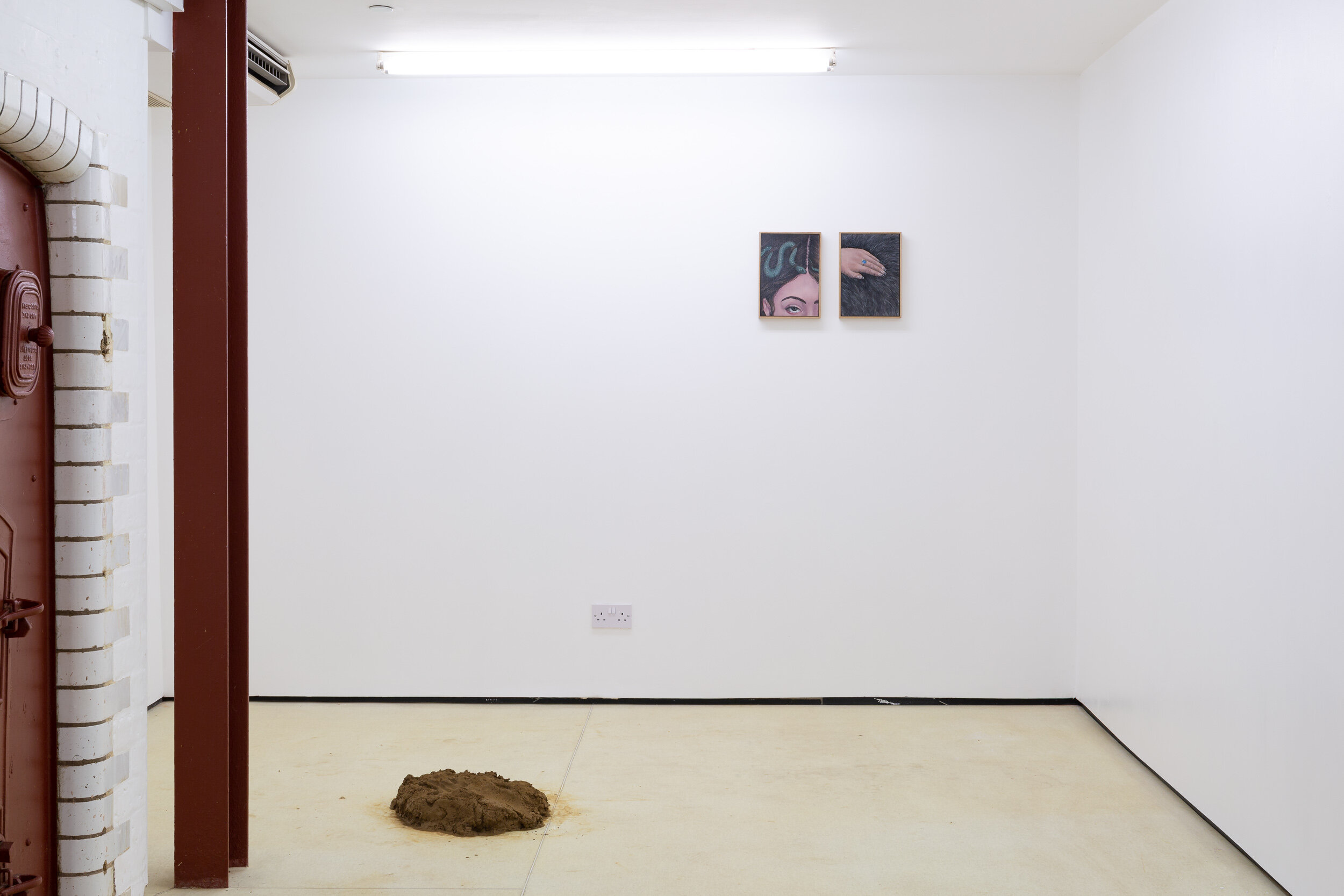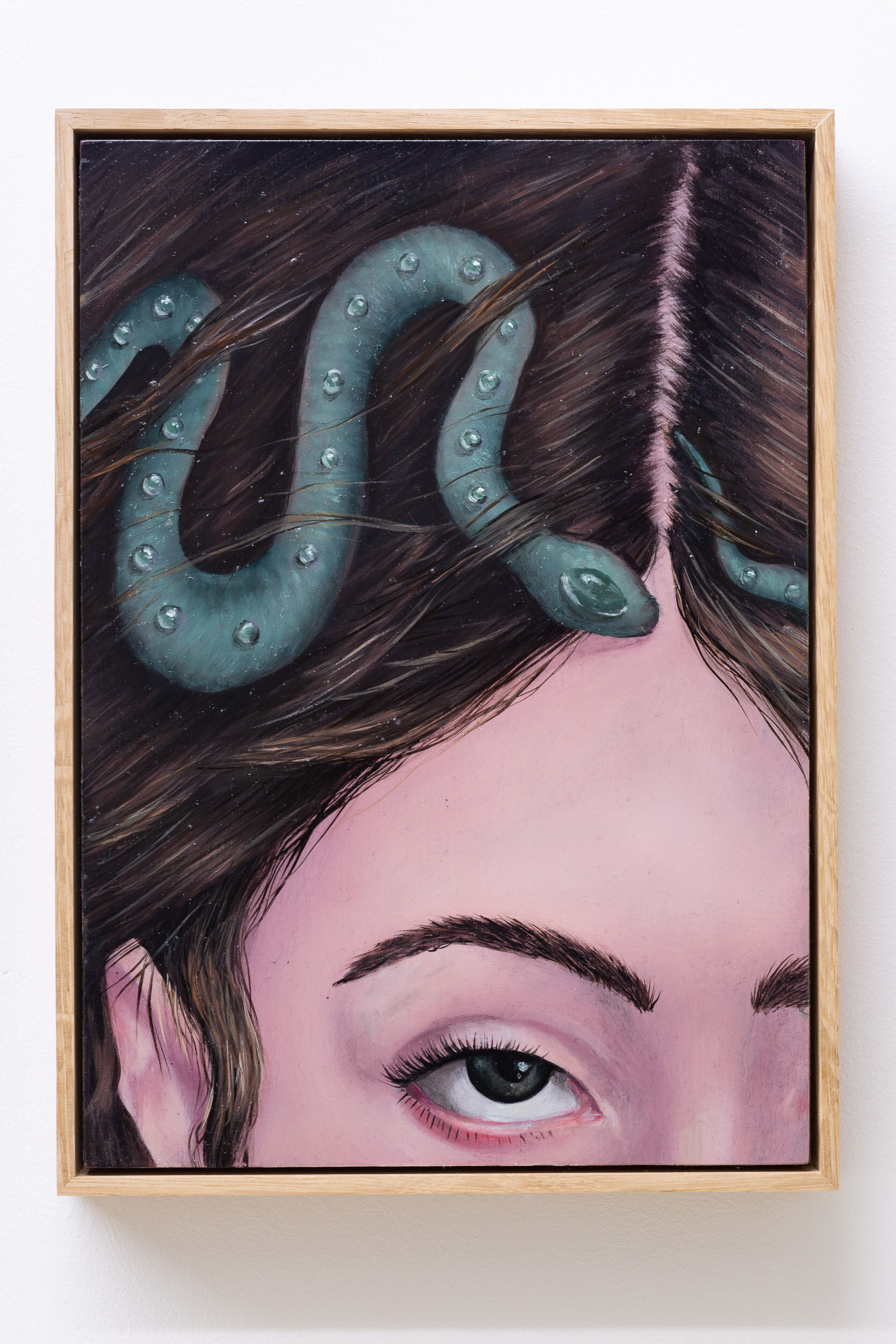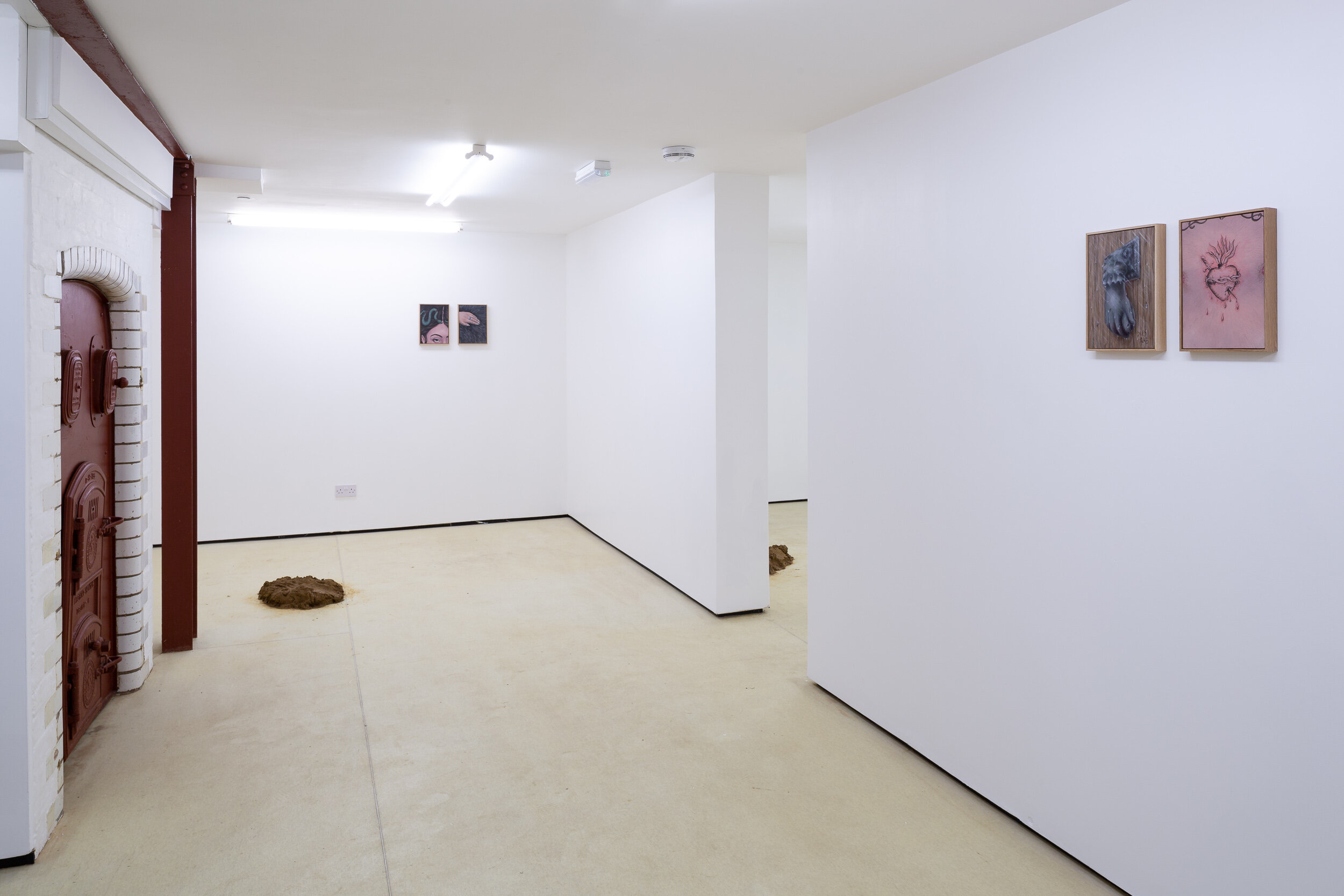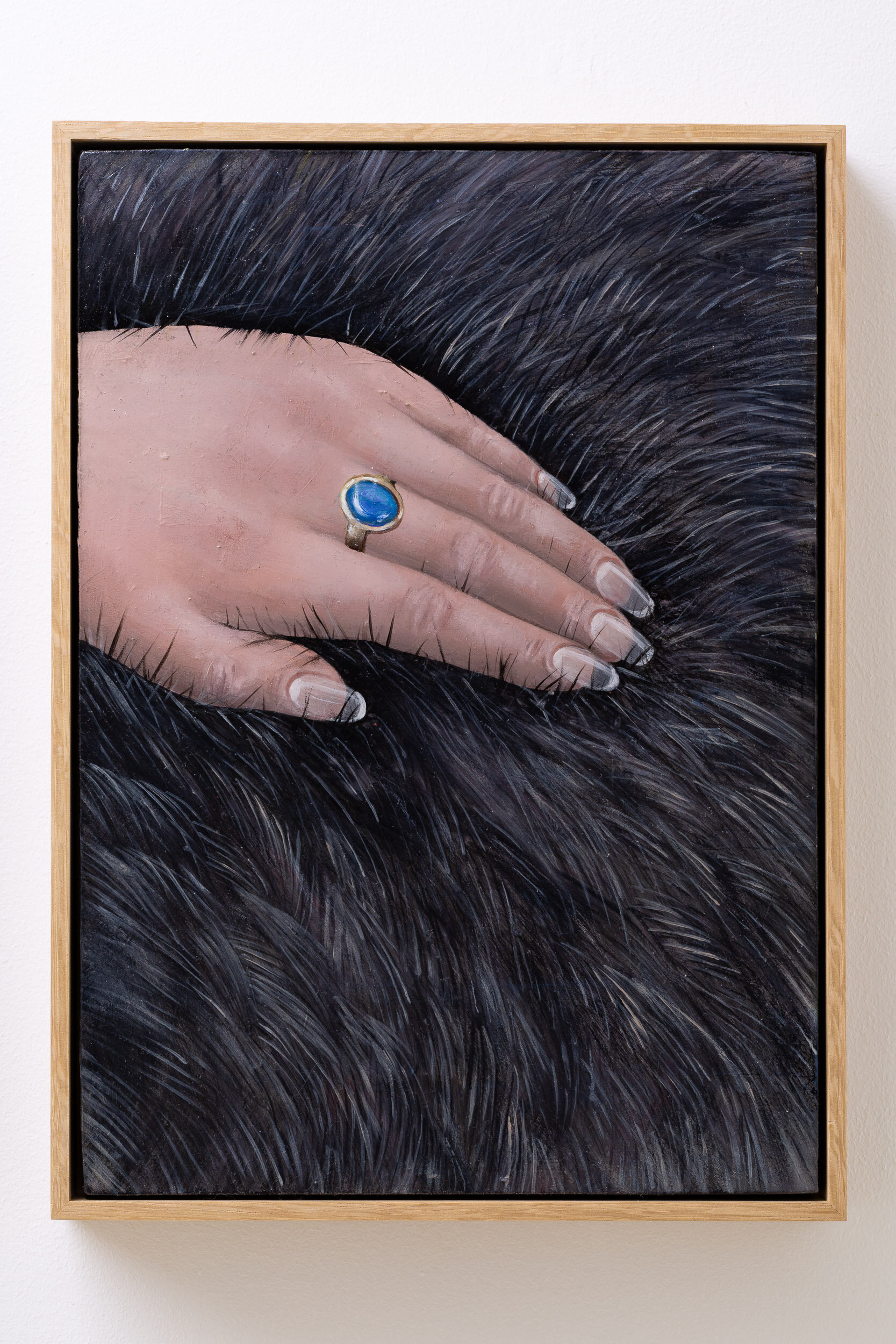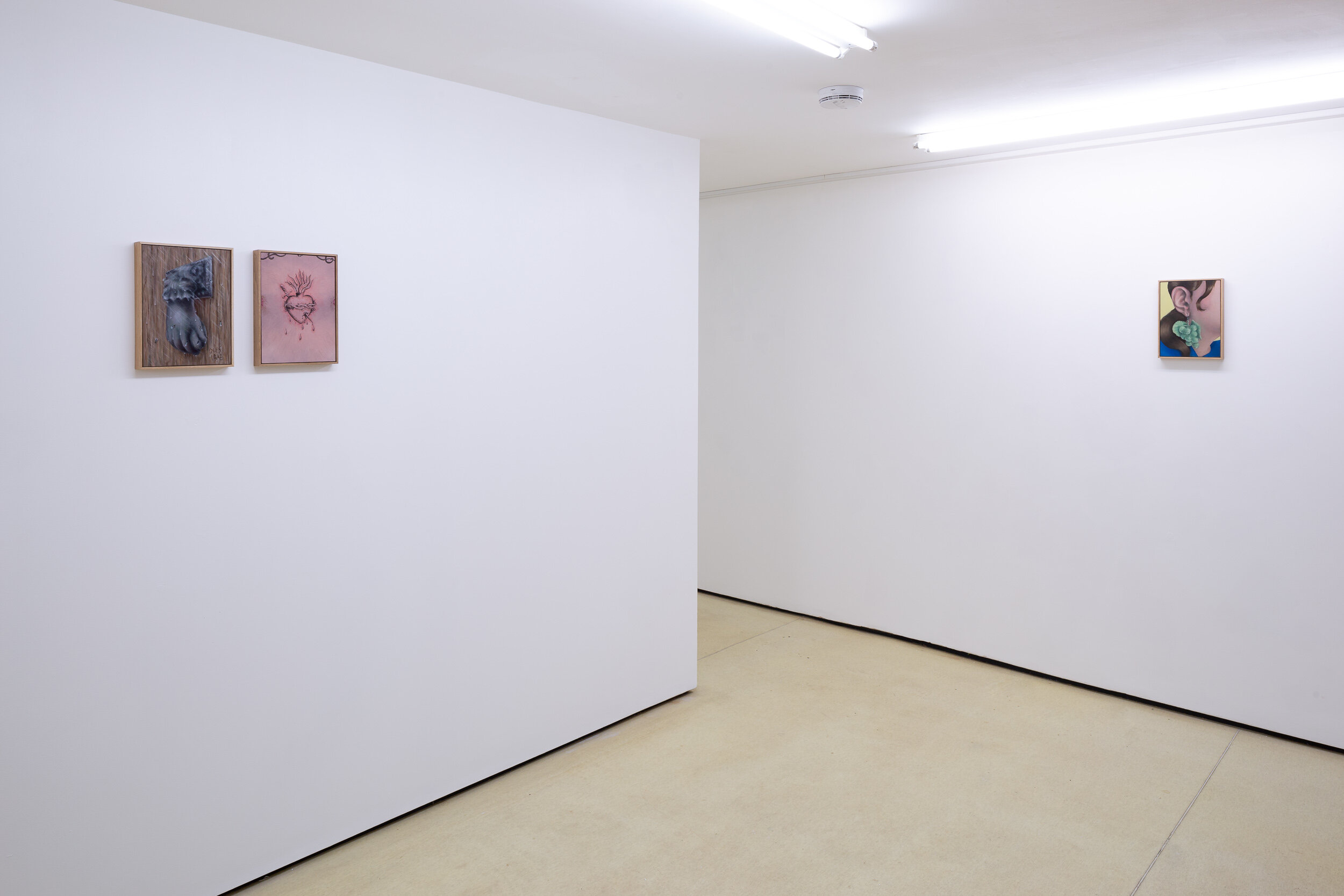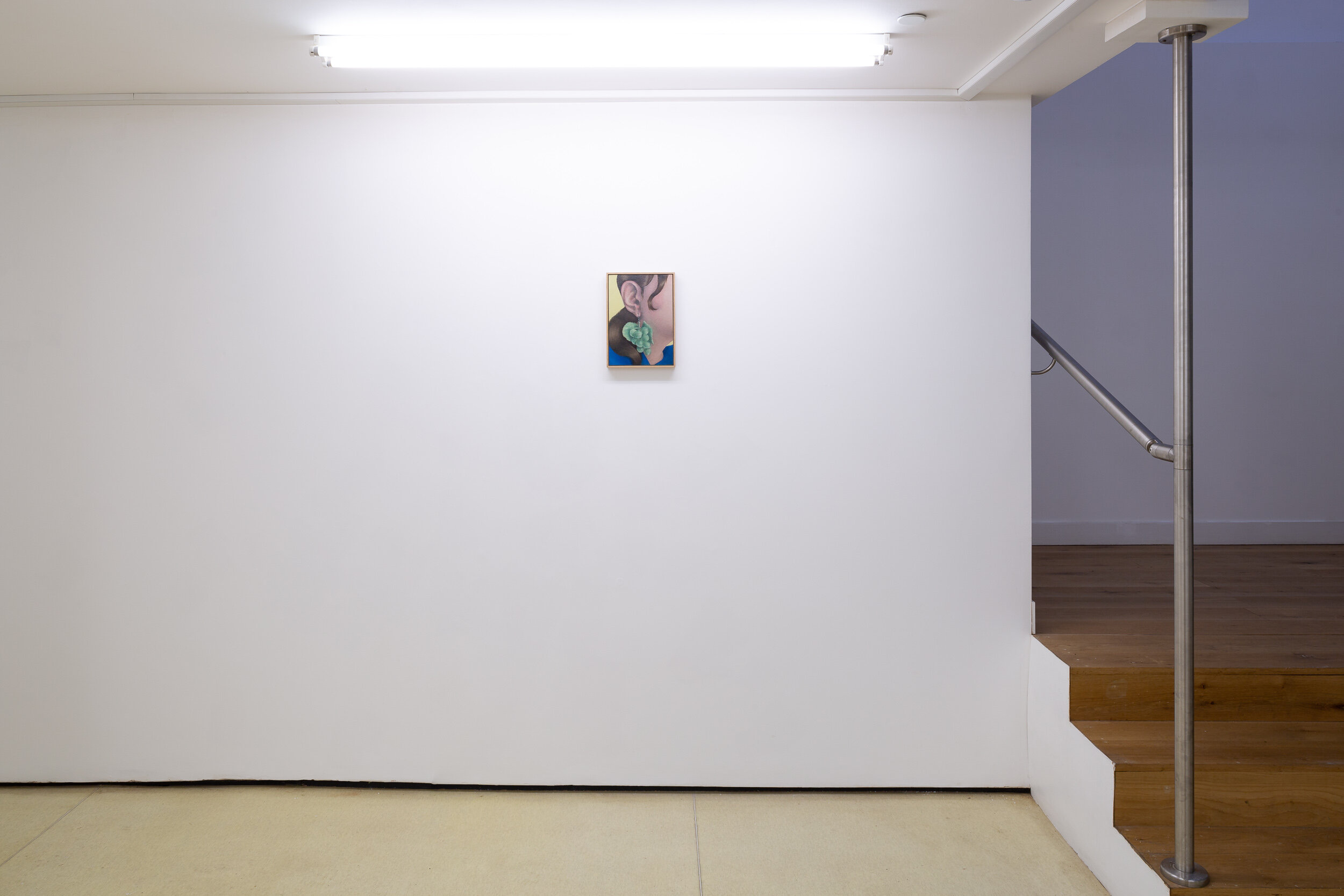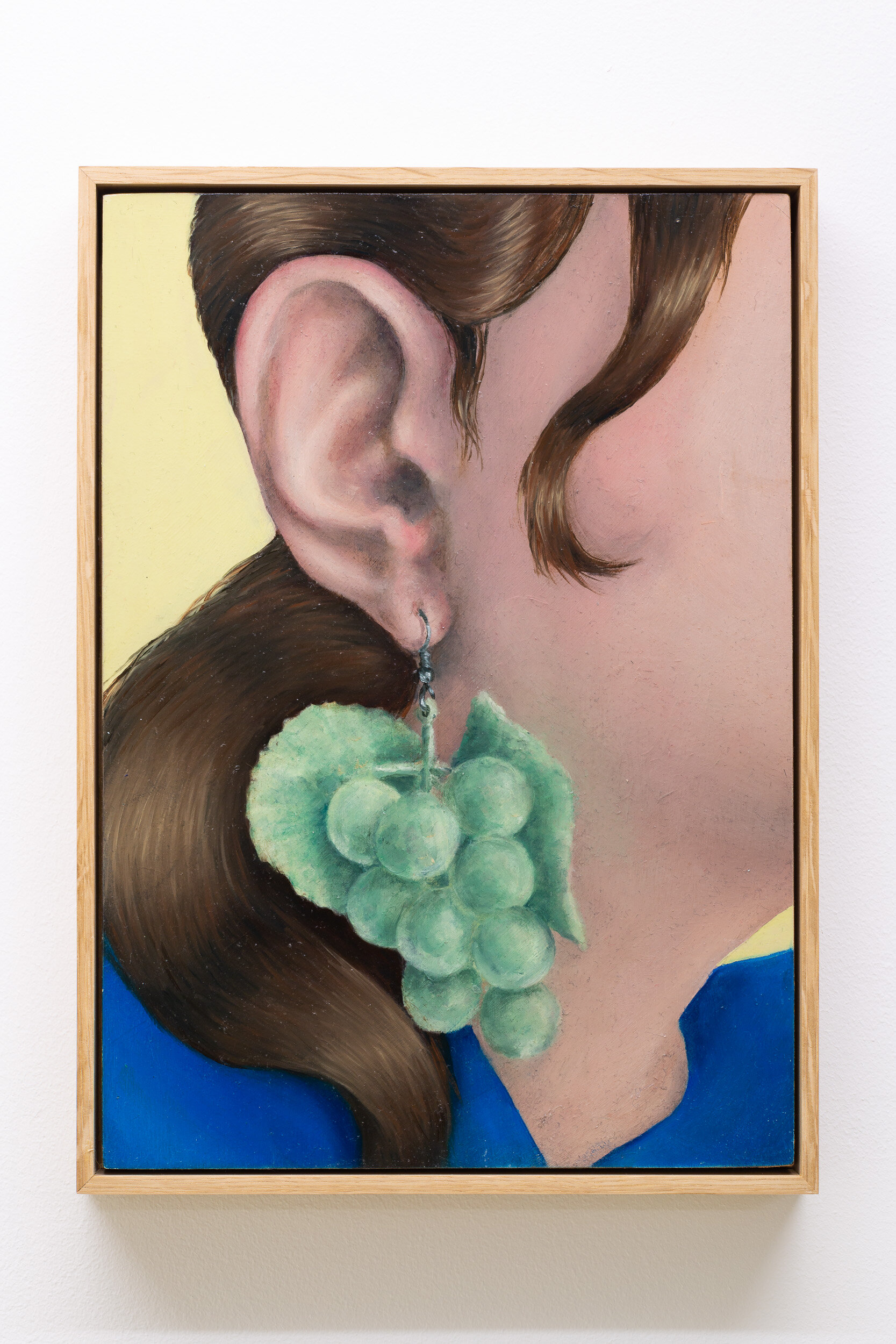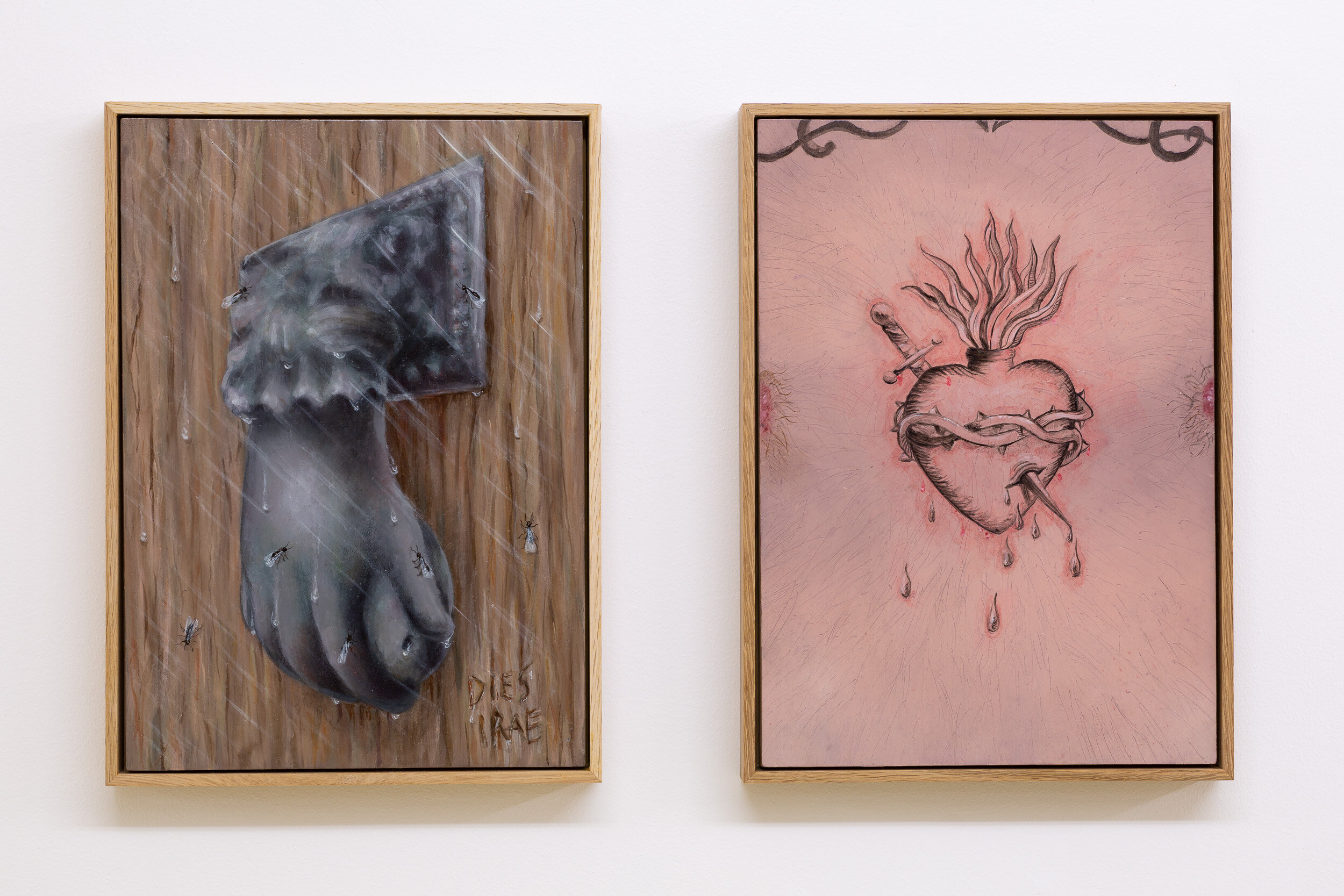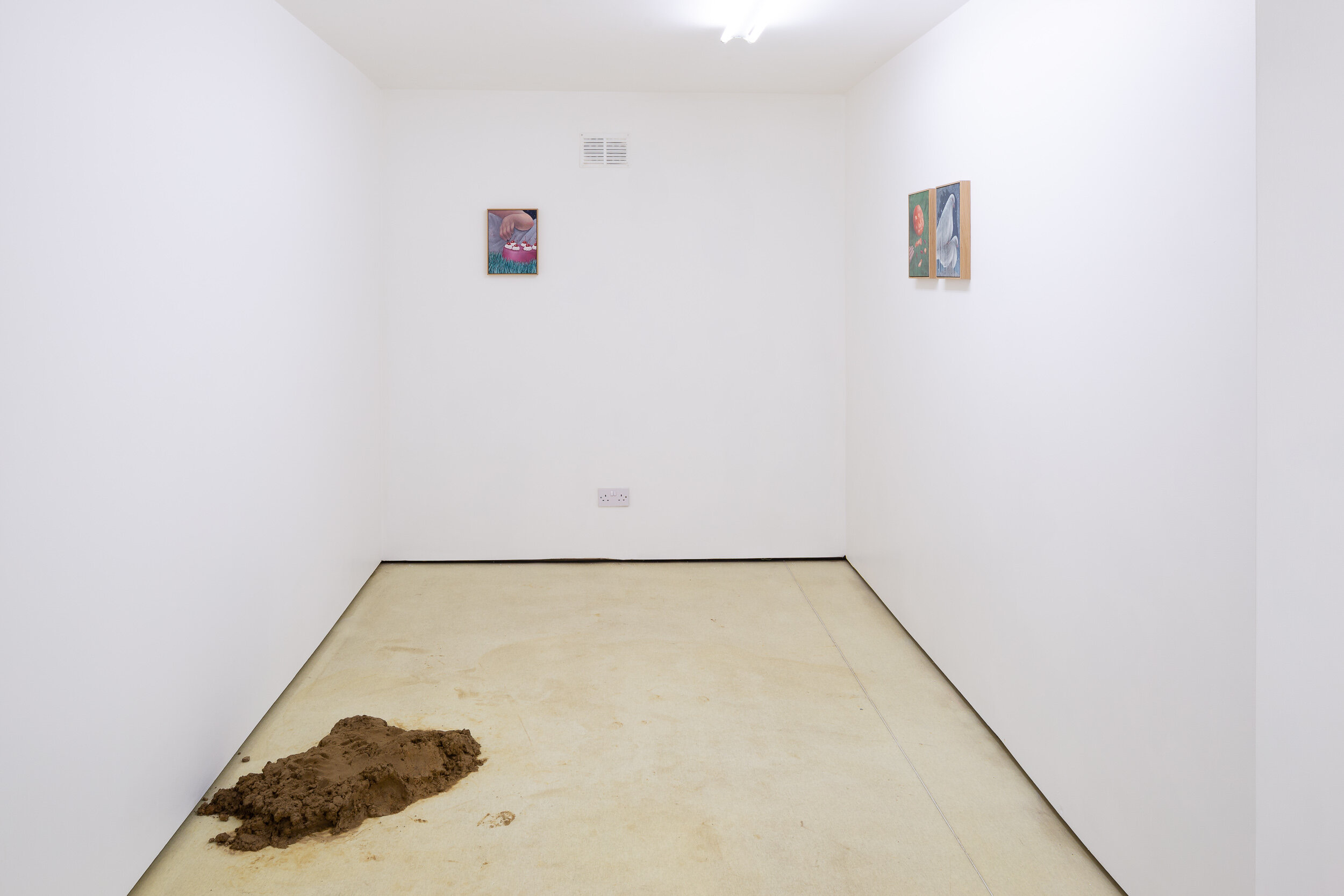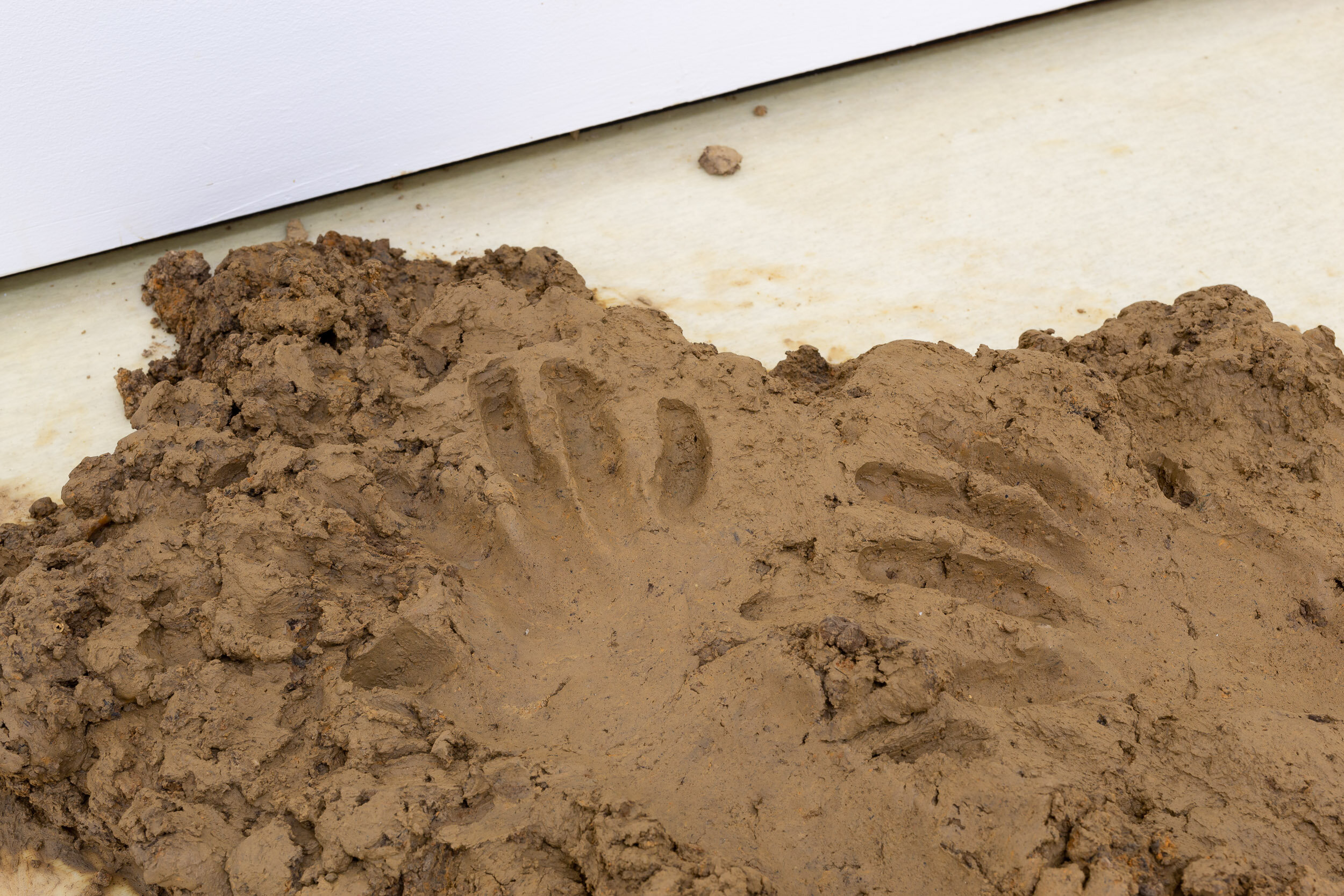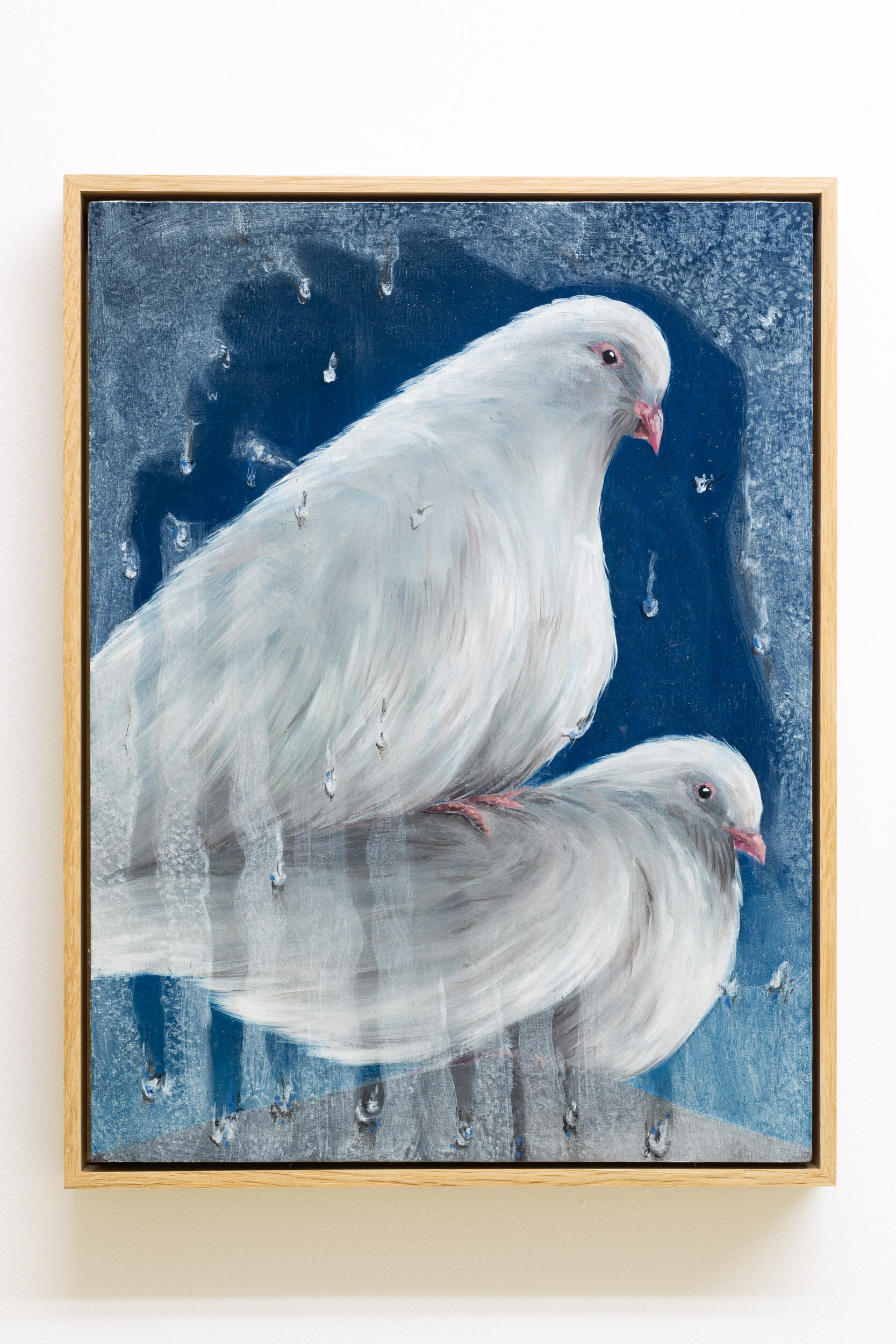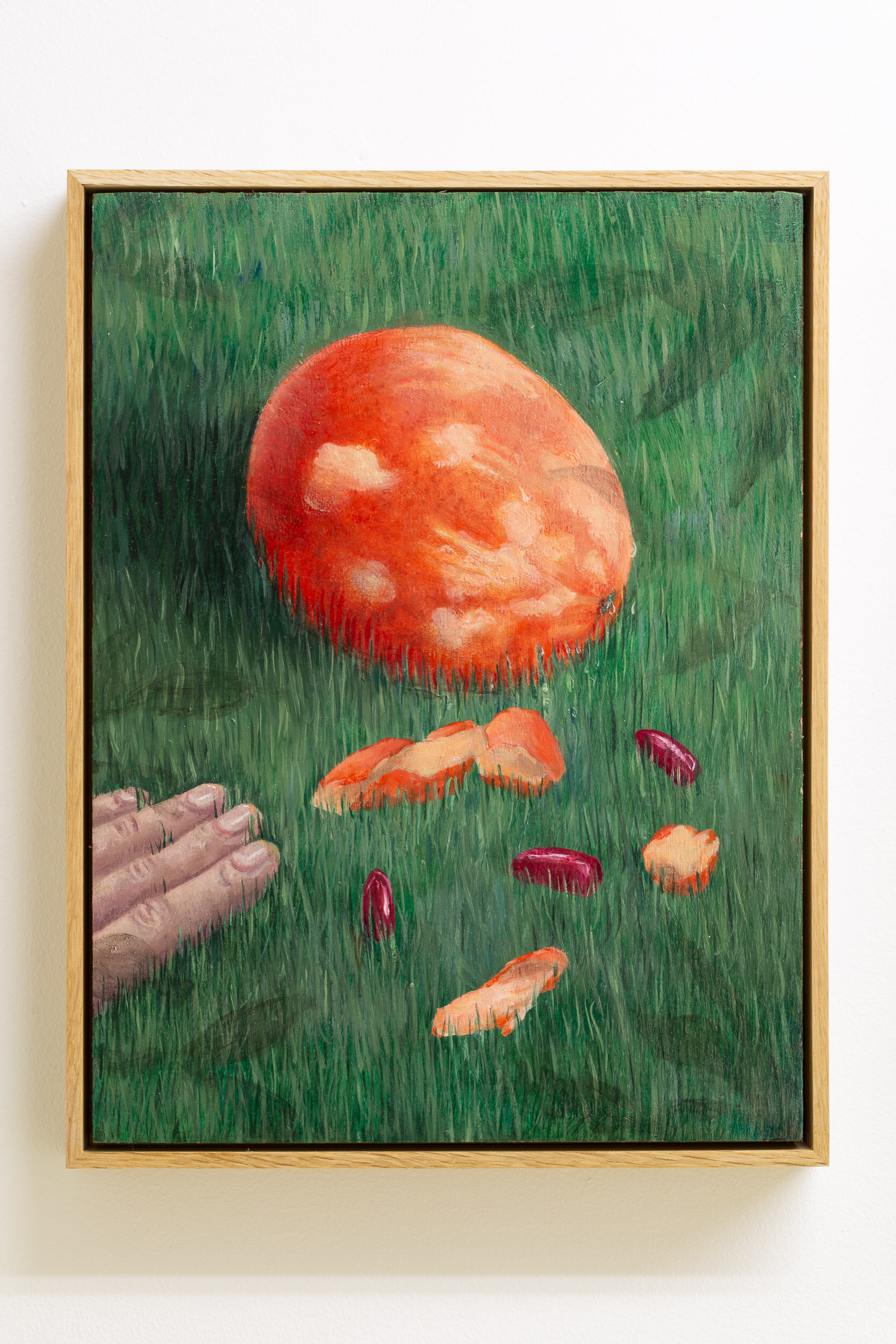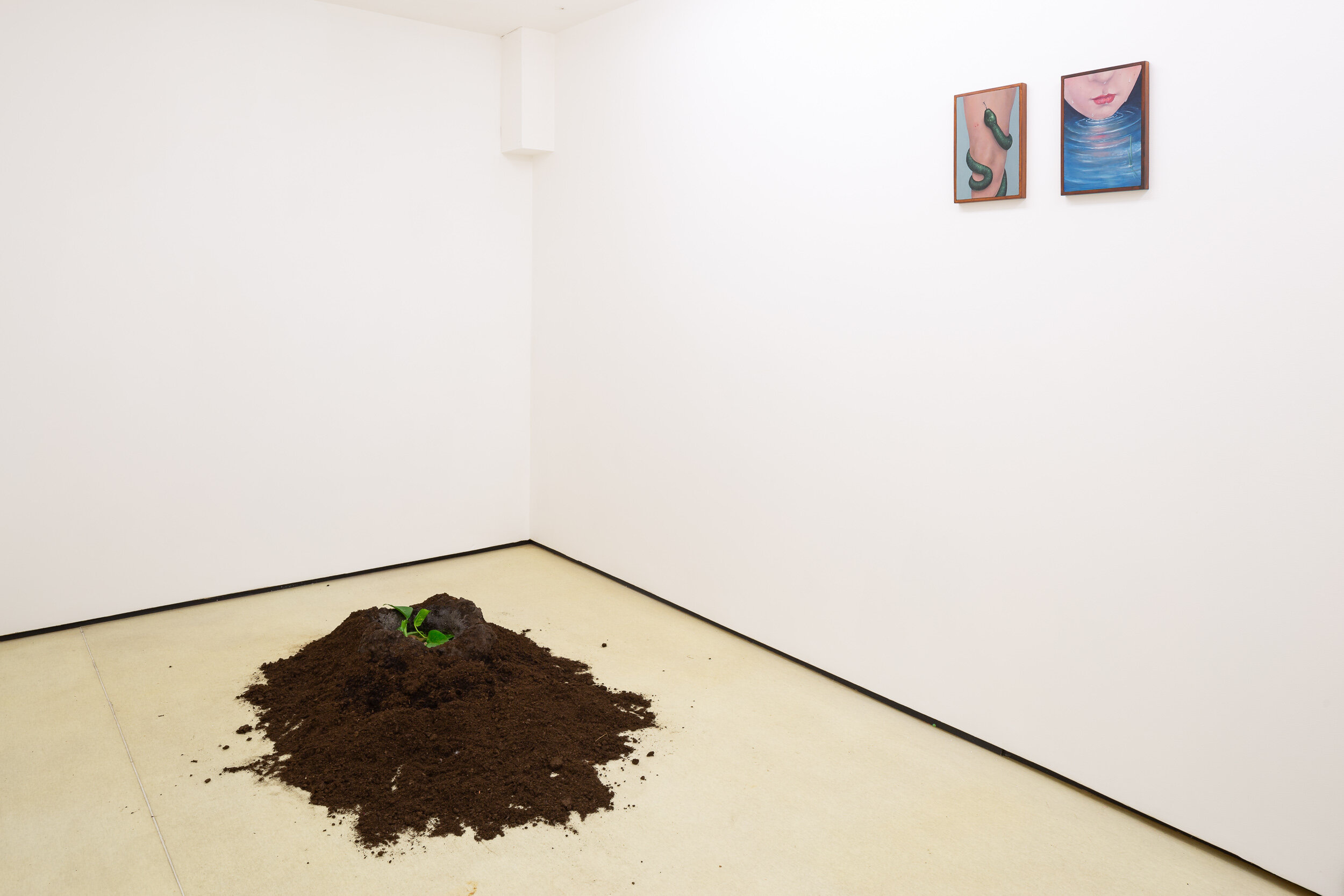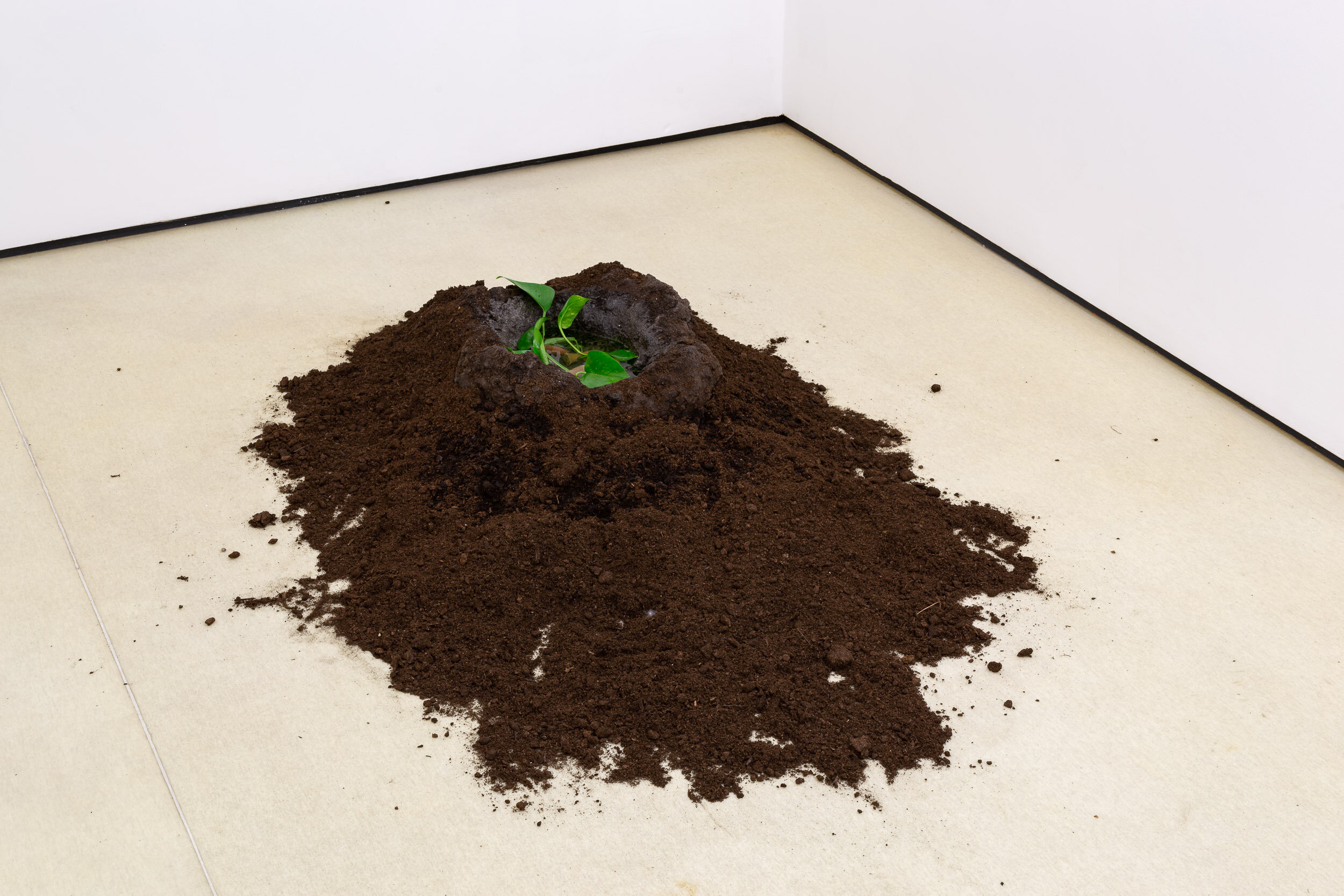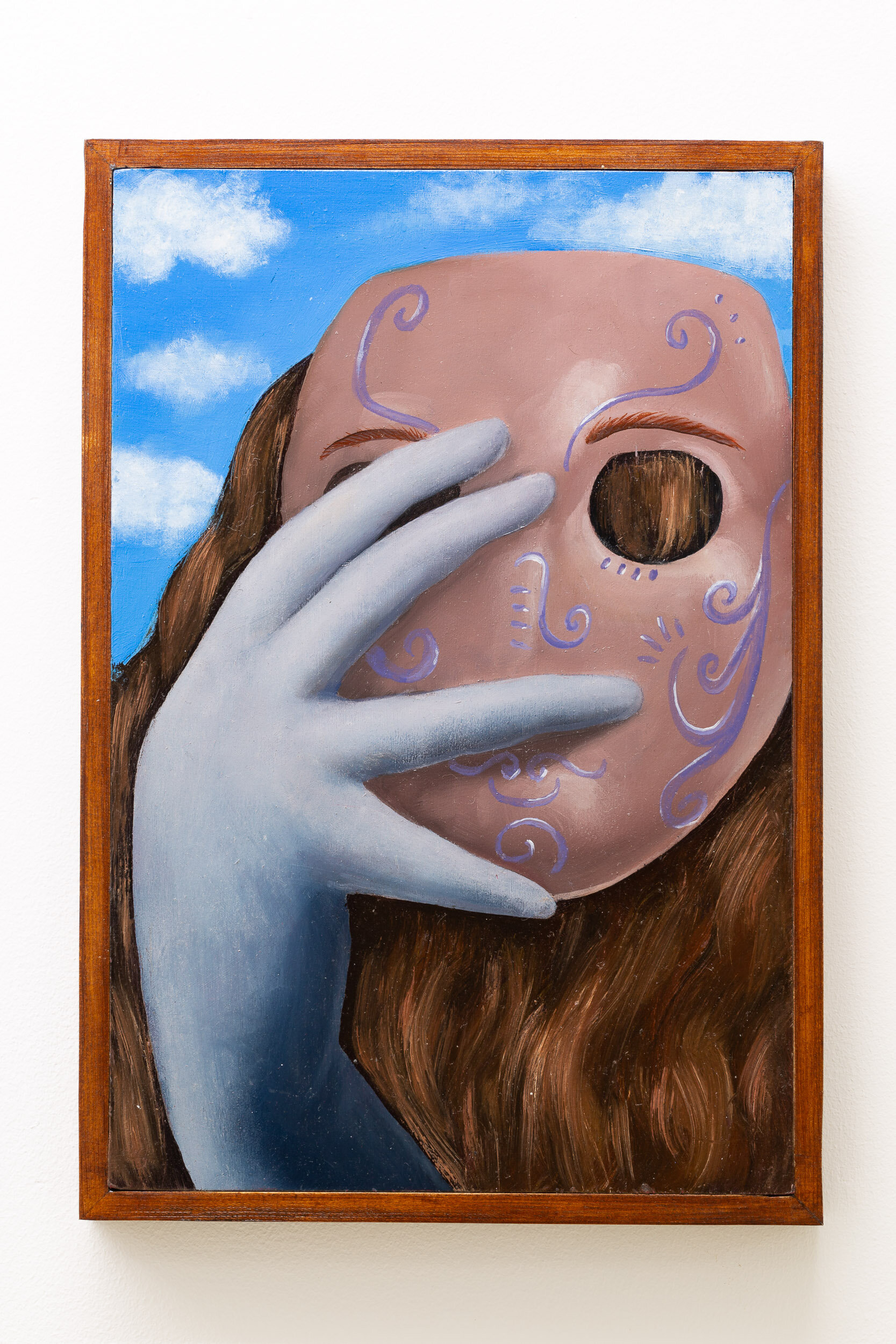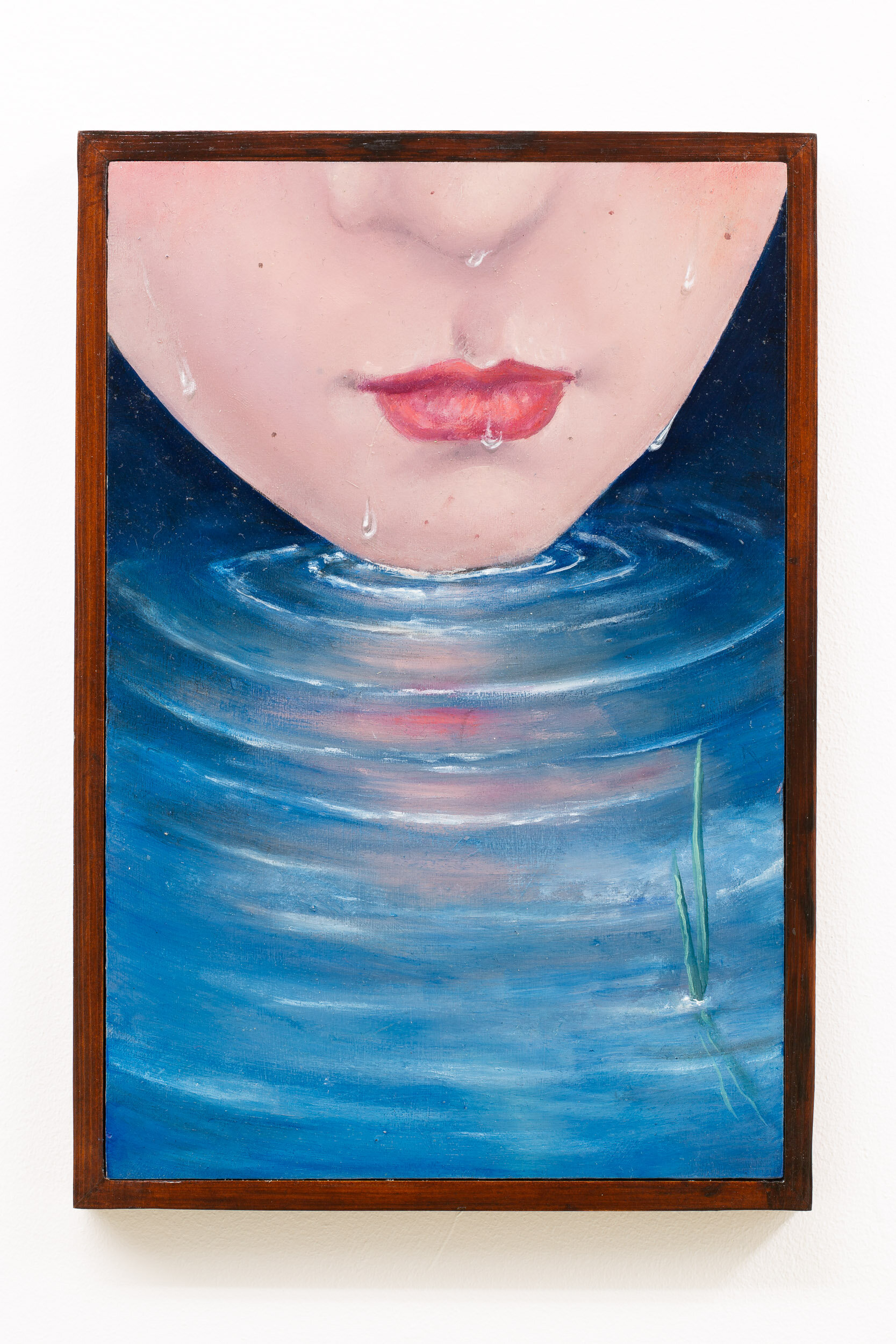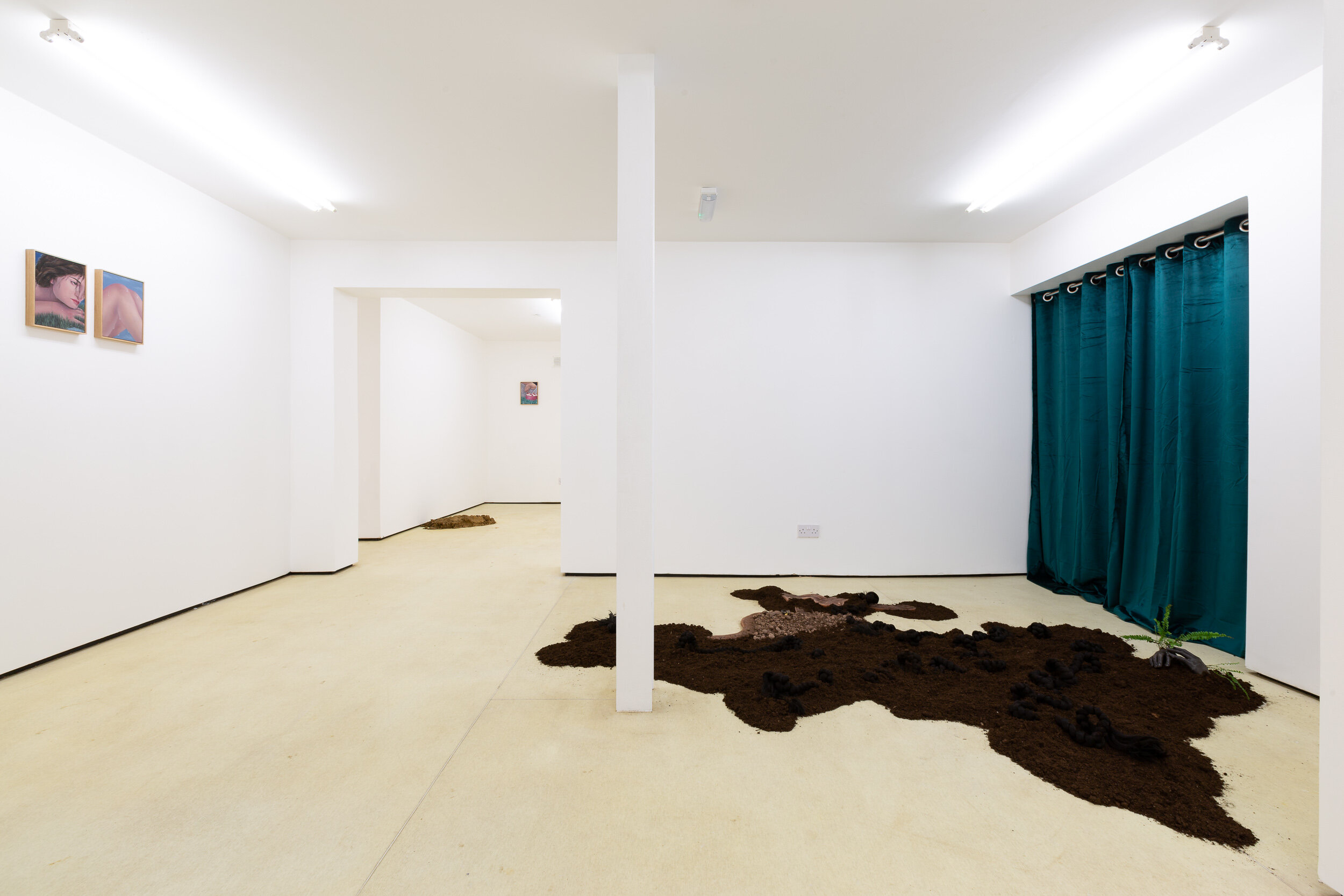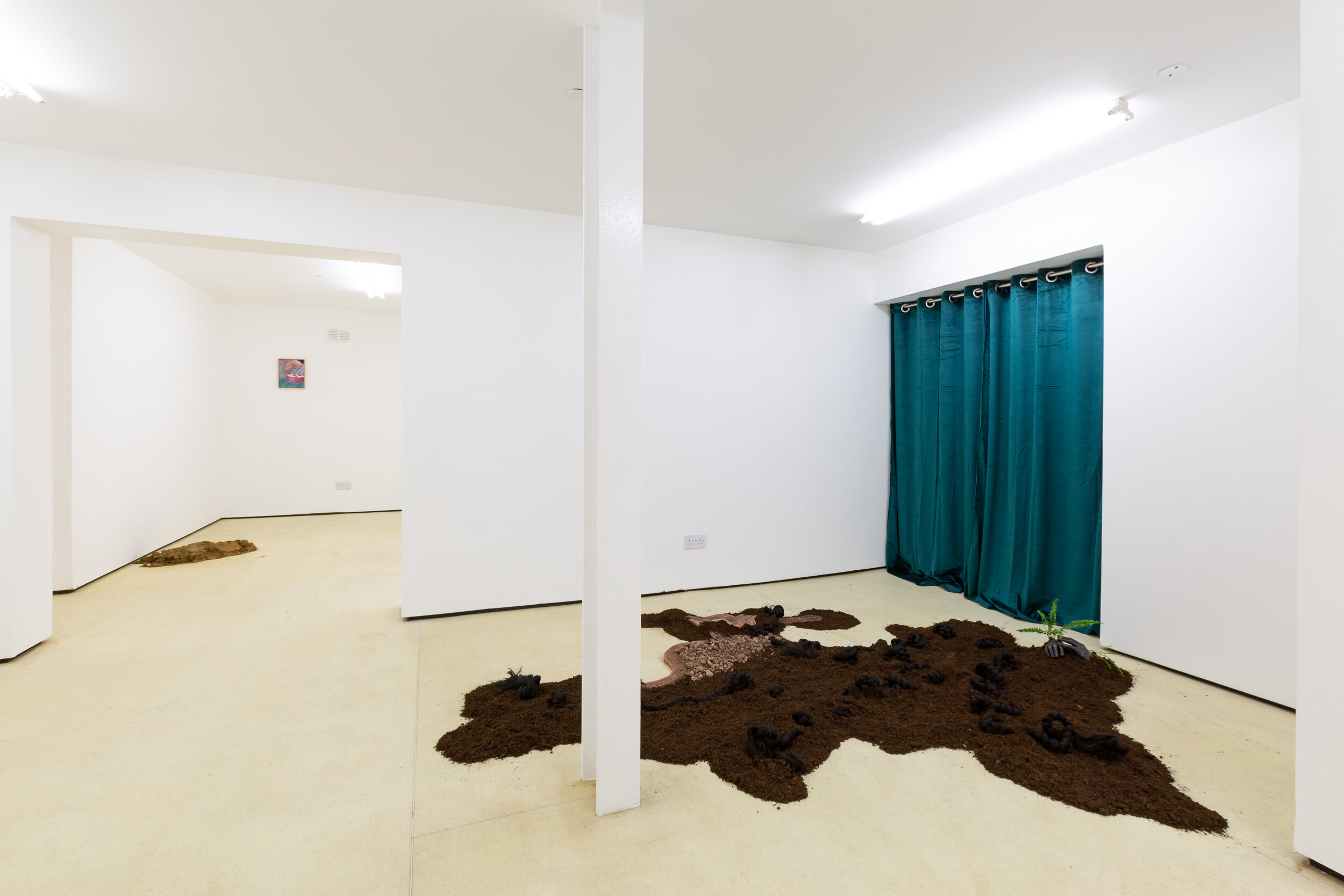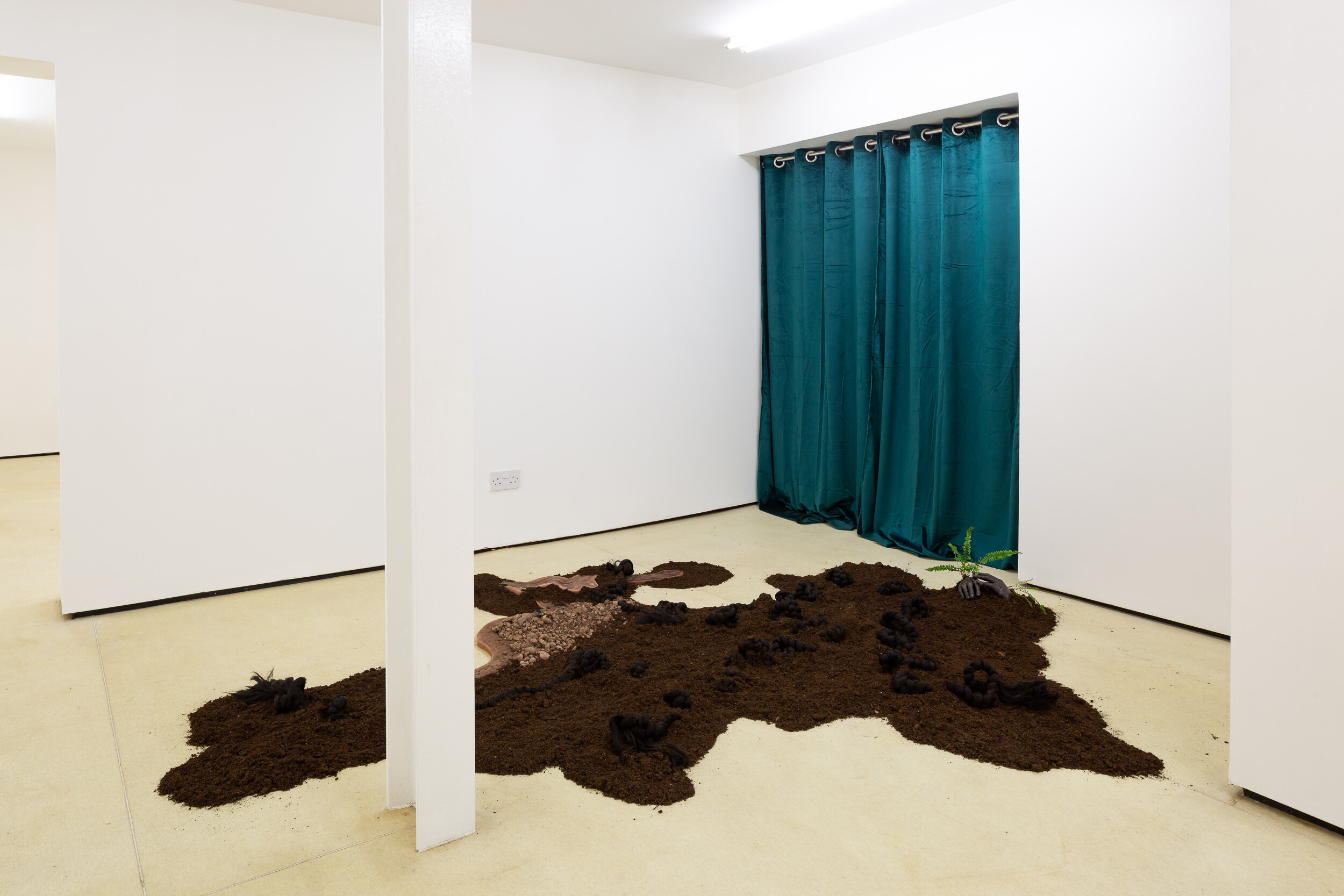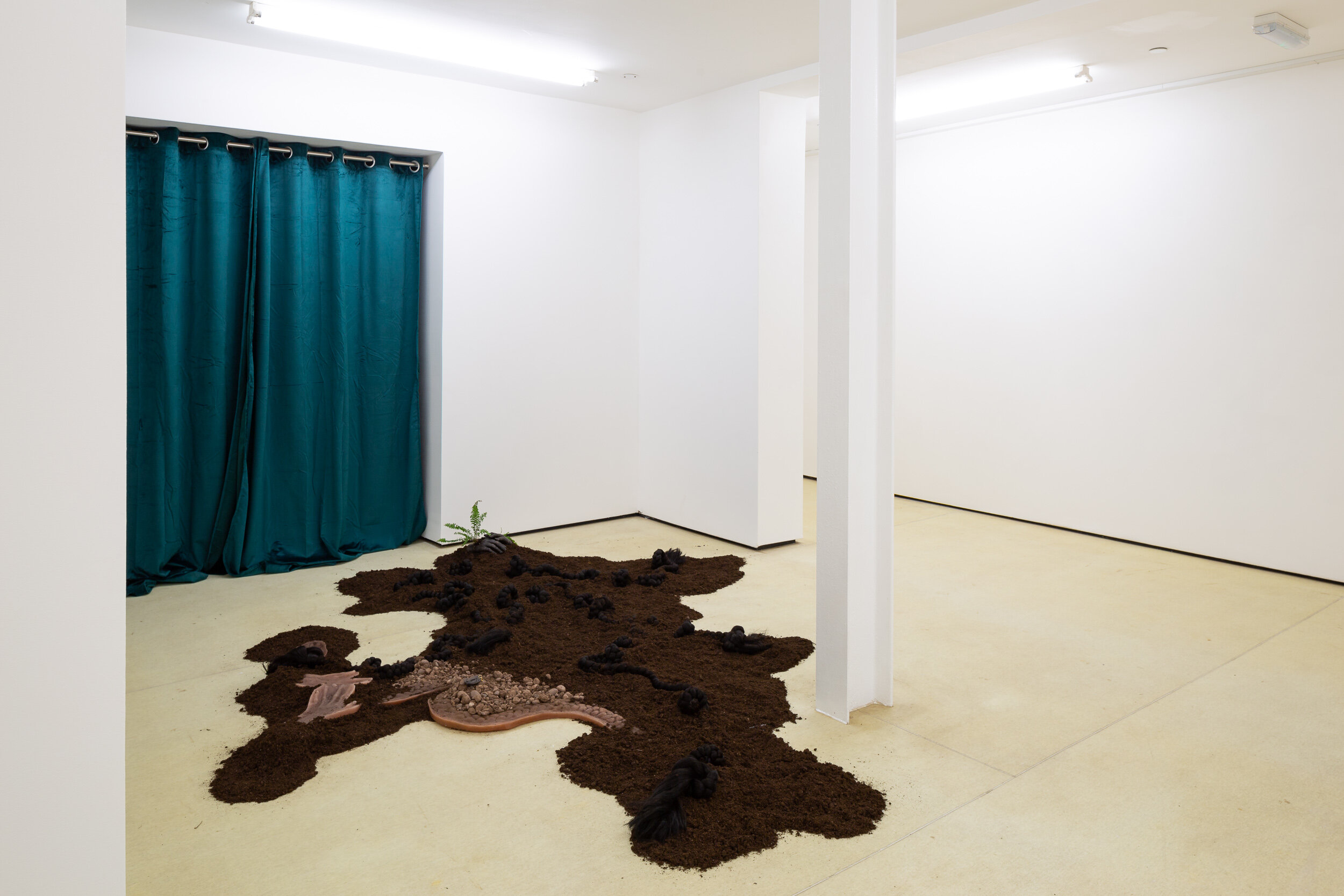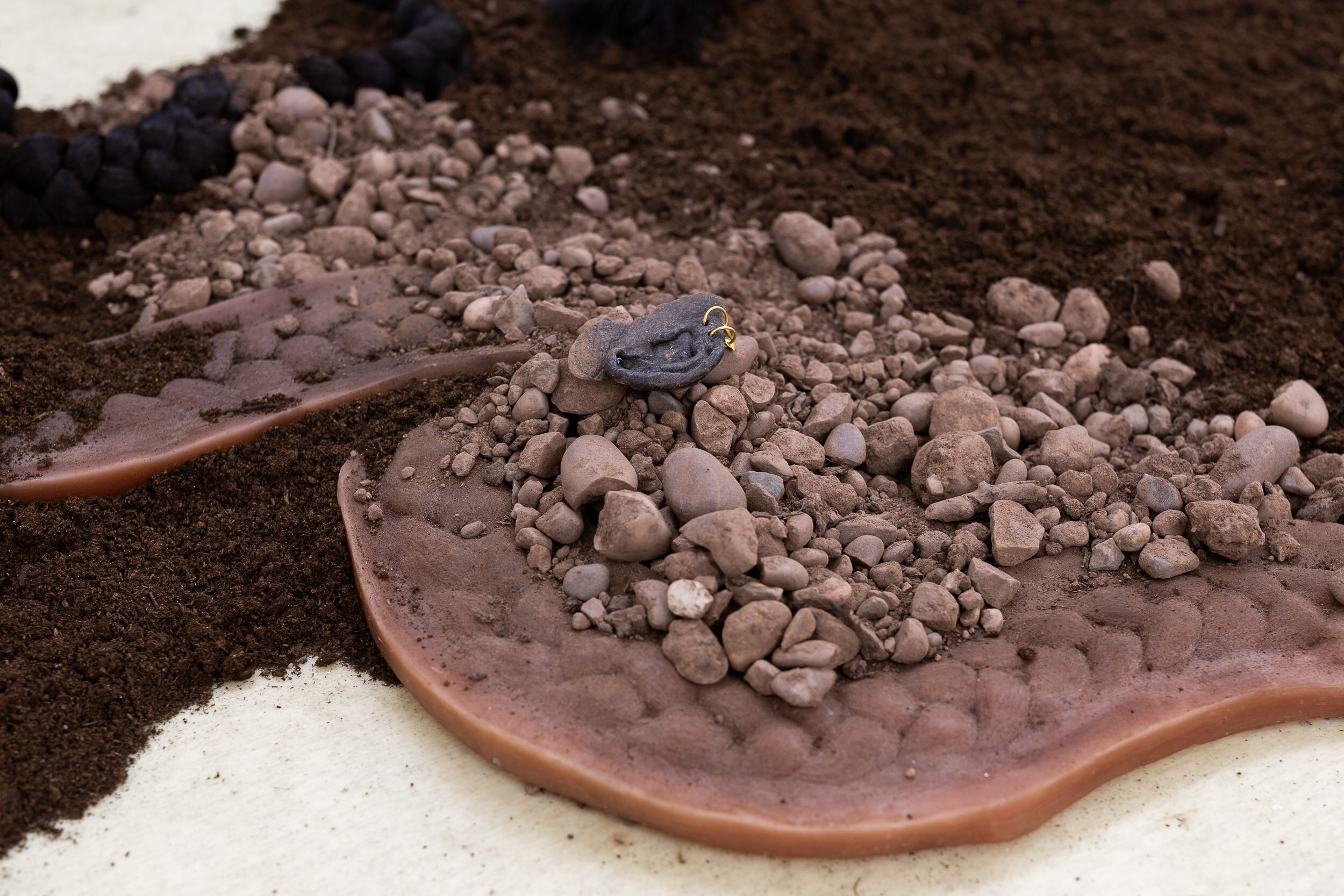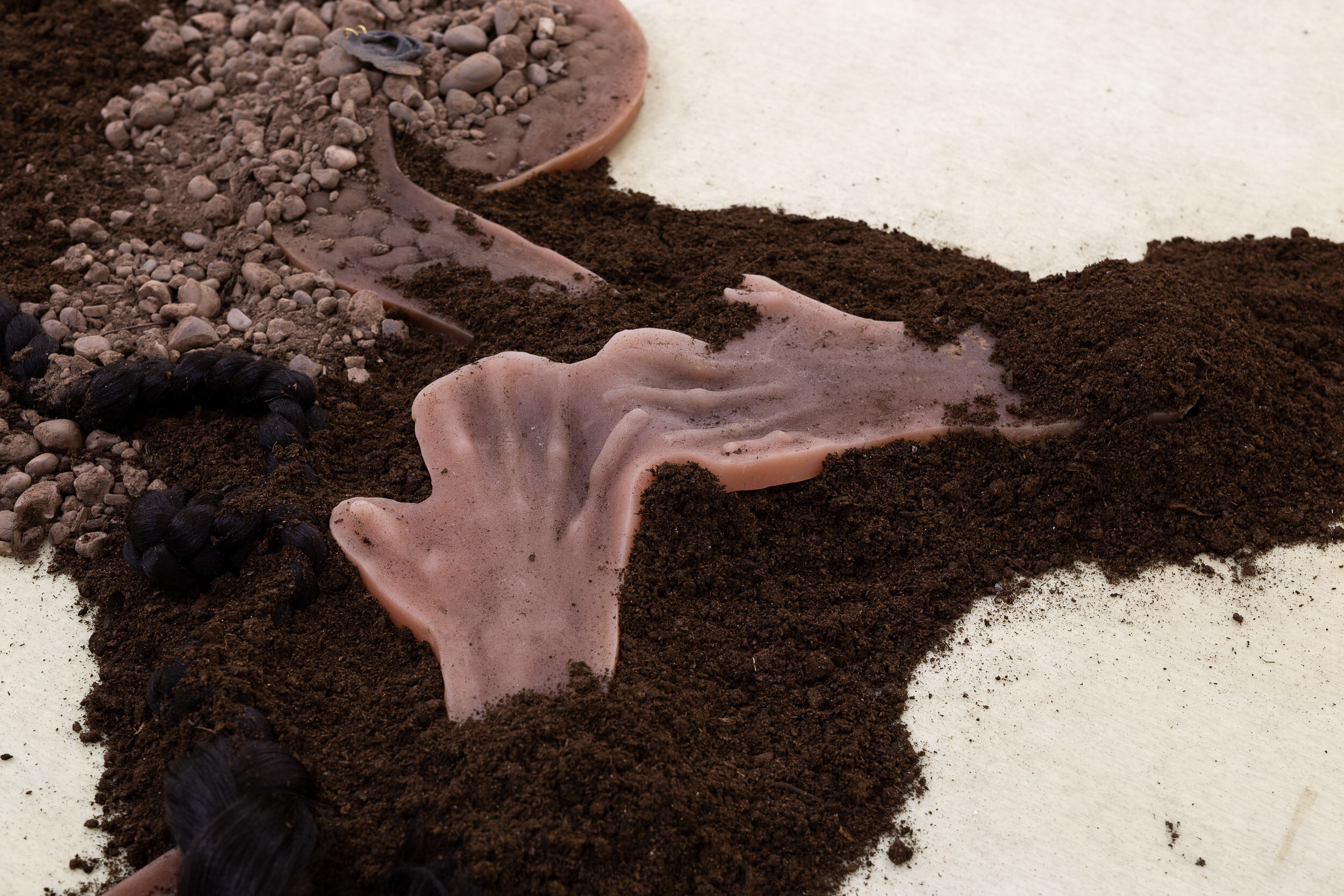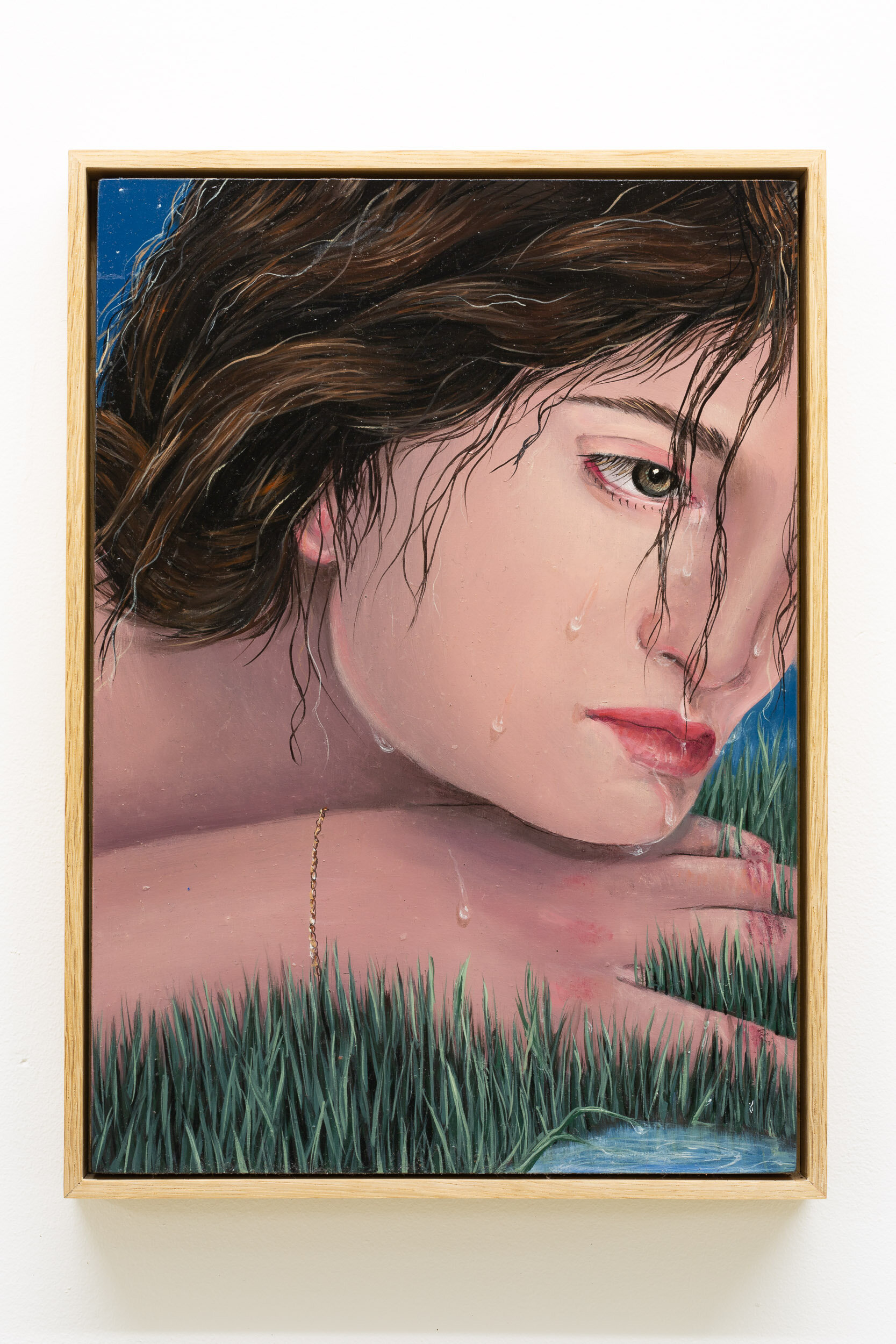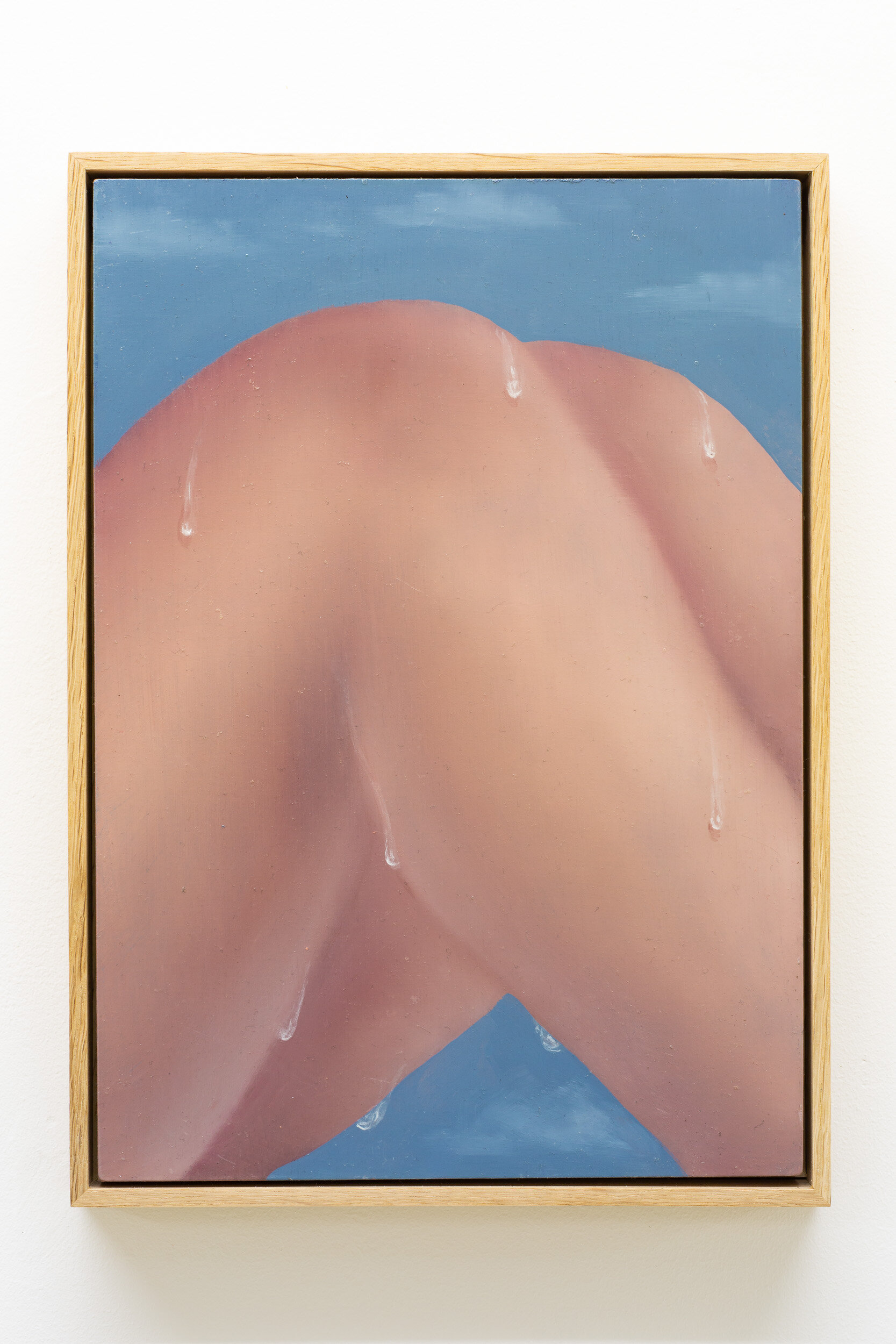I Am Unsure As To If It Is Still Alive - Natalia Gonzalez Martin & Davinia-Ann Robinson
April 17th 2021 - May 2nd 2021
“For souls it is death to become water, and for water death to become earth.
Water comes into existence out of earth, and soul out of water.”
— Heraclitus, fl. 504-1 BCE
One imagines the soul as that in which resides the eternal—iridescent and precious. Since ancient times souls were the harbinger of immortality, conferred with reverence as gilded aureoles of palladium and gold. To be ensouled was to possess anima, a vital principle or “breathe of life”. Earthly bodies, simply the surrogate presence for that which persists beyond the limits of earth and presence. Souls were—and continue to be—the transitional ether between life and afterlife, spirit and flesh, heaven and earth, the enduring embers of our bodies. The works of Natalia Gonzalez Martin and Davinia-Ann Robinson are similarly concerned with the enduring and the soul, the capacity to “continue to exist” through time, but also to endure—Old French root, endurer—“to undergo or to suffer”, to carry on despite obstacles or hardship. I Am Unsure As To If It Is Still Alive is a reconciliation with the truth that we change without ceasing, that body, earth and soul—despite their displacement, dispossession or exile, or precisely because of these—are inseparable, sacred, on fire with the same force that lit the stars.
Heraclitus wrote that, “For souls it is death to become water, and for water death to become earth. Water comes into existence out of earth, and soul out of water.” Conceiving the soul as a living memory conterminous with all life, a series of paradoxes are presented to us. I Am Unsure As To If It Is Still Alive does not seek to explain these paradoxes—between absence and presence, resilience and entropy—rather to reveal them, to confess or disclose a mutual vulnerability. Gonzalez evokes the Sacrament of Penance in secular icons that are nothing if not cathartic: the inscription of religious and cultural heritage on one’s physical body and moral codes. Robinson, in contrast, sublimates and affirms the corporeal soul with that of earth and landscape, confiding her experiences as a body of colour dwelling in colonial environments. Both are charged with the rush of time—permeated by ancient entities or encounters of the past—yet resist accumulation or ownership of the future.
For Gonzalez, this antimony is felt in the proximity of ecstasy and dysphoria, captured in the weeping visage of Mary—a symbol of special significance for Catholics: she cries not only over the sins of the world, but also over the pain she endured in her earthly life—as with her references to the myth of Narcissus, in which a reflective stare is elided for ambiguous sensuality, subtly negating the classical dwelling-place of souls in ancient Europe—saiwaz, meaning “from the lake”—for a quiet and serene enchantment. Here, the transcendent and corporeal are mutually constituted—mirrored in the water, so to speak. Conversely, fragments of Robinson’s body are directly entangled in the process: pigmented thumbs, ears and hands. Embedded in soil drawn from sites of personal distress, they intermingle with the surrounding terrain in reciprocal penetration and intimacy. No less, shards of a softly spoken voice share their syntax with a body of earth and rock: words rupture and desiccate, giving way to faults in the aural landscape.
Composed of golden jewellery, small green plants, hair, soil, and water, Robinson’s works materialise physically that which is formally represented in Gonzalez. For the former, these express the enforced dislocation and dissociation of bodies of colour with their natural environment, to which environmental feminist Astrida Neimanis writes, “we must urgently pay attention to how bodies and places respond to our weather-worlds”—and to which we might say for Gonzalez, applies equally to the netherworlds of inherited faith, tradition and religious iconography. In each case—it would appear—a soul cannot be extracted from its history, its symbolic or material landscape is a living archive and its scars a shared memory. Despite this common depth and spiritual agency, formal differences remain: the libidinal mysticism of Gonzalez juxtaposing the eerie ‘presencing’ of Robinson. These differences are not only complementary but essential, for as Neimanis does not forget to underscore, “not all bodies weather the same”.
I Am Unsure As To If It Is Still Alive presents an evocation of the soul as divine tragedy is sublimated to a set of secular conflicts—between cultural heritage, sense of self, climate and landscape. In a reversal of Baudelaire’s old dictum, these are distillations not of the eternal from the transitory but the transitory from the eternal, echoing the cyclic mantra of Heraclitus and the inherent paradoxes of a shared soul. In their work, Gonzalez and Robinson abolish boundaries between divine, secular and earth in order to gesture toward other ways of desiring, feeling, or being in the world, attuned to these paradoxes. For each, the soul cannot be without a body—but what that body is, or might come to be, is precisely that which cannot be articulated: it is the glistening warmth of hope and compassion felt against what we are forced to endure, and to live in the power of this truth.
Written by Charlie Mills
Natalia Gonzalez Martin
Through the use of traditional techniques, Natalia's work adopts the format of icon paintings. Through these, she explores the traces we have been left with from traditions that have prevailed over mainland Europe for centuries and their capacity to continue to exist through time.
The characters that rule these paintings borrow direct inspiration from hagiographies, specifically the ones compiled by Jacobus de Veragine in The Golden Legend and its counterpart, the satirical version Anti-Saints created during the french revolution by Sylvain Maréchal. The work merges the characters from these fables with the constant supply of images we are subjected to daily. Natalia's work blurs the boundaries between divine, secular and earth in order to gesture toward other ways of desiring, feeling, or being in the world, attuned to these paradoxes. The pieces are entitled by proverbs or sayings passed down orally, reflecting on a shared approach to life that has been accepted without comment or revision.
Born in Spain, Natalia graduated from Fine Art Painting at City & Guilds of London Art School in 2017. Since then her work has been exhibited in several group exhibitions including Old Friends, New Friends, Collective Ending, London (2021), The Artist Oracle, White Crypt Gallery, London, (2021), Back To Back, The Artist Contemporary, London (2021), Frozen Time, Annarumma Gallery, Naples (2021), Always Winter, Brooke Benington Gallery, London (2020) and has participated in the AucArt Lab Residency, London (2019), Woolwich Contemporary Print Fair, London (2018) as well as being selected for YICCA 2018 Art Prize, Hernandez Art Gallery, Milan (2018).
Asides from her practice, Natalia is the co-director alongside Nina Silverberg of Subsidiary Projects, an artist-led space to promote the work of emerging artists.
Davinia-Ann Robinson
B. 1987
Davinia-Ann’s practice examines how ‘Presencing’, fugitivity and tactility undo colonial and imperial frameworks through which nature and Bodies of Colour are articulated, by exploring the relationship between Black, Brown and Indigenous soil conservation practices and what she terms as ‘Colonial Nature environments’. Her work addresses personal interactions with ‘colonial emotions’ she has encountered, in local, national and global environments as a Black Female Body, building on her intense relationship with soil as a living material explored through sculpture, sound, writing and performance.
Davinia-Ann is currently studying in her final year at the Slade School of Fine Art on the MFA Sculpture programme, She has been included in solo and group exhibitions and delivered public programmes within arts intuitions, recent include: Tactile Belonging - Mimosa House London (2021) Bold Tendencies, London (2020), Freedom Is Outside the Skin - Kunsthal 44Møen, Denmark (2020), Working Progress - South London Gallery, February and August (2020), PRESENCE - Deptford X, London (2019), The Politics of Pleasure, Genealogies Series, PLASTICISED SENSATION – ICA, London (2019).
Davinia-Ann is a recipient of the Felix Slade Scholarship 2019-2021 and a recipient of the 2021 SET Studio Prize. She is also founding member of Narration Group an art collective for Women and Non-binary People of Colour.
